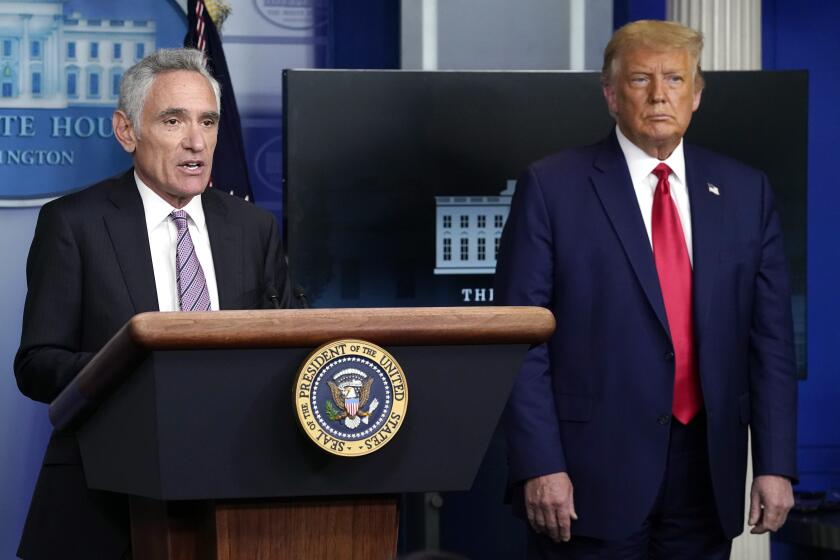Study finds removing school mask mandates contributed to 22,000 U.S. COVID deaths in a year

- Share via
Someday we Americans may stop quarreling over our response to the COVID-19 pandemic — lockdown orders, social distancing and so forth — but one category of debate may never become immune to second-guessing.
That’s the impact of anti-pandemic measures on schools and schoolchildren. According to popular opinion, these were almost entirely mistaken or ineffective.
A newly published study from data scientists at Michigan State University knocks one pillar out from under this claim. It finds that the abrupt removal in 2022 of mandates that children wear masks in school contributed to an estimated 21,800 COVID deaths that year — a shocking 9% of the total COVID deaths in the U.S. that year.
COVID-19 is less of a threat to children than accidents or the common flu.
— NIH Director Jay Bhattacharya (2022) gets an assessment of child health dead wrong
“We were surprised by that too,” says Scott A. Imberman, a professor of economics and education policy at Michigan State and a co-author of the paper. On reflection, he says, given the mixing of children and staff in the close quarters of a classroom, “it’s pretty easy to see how COVID could propagate to the wider community.”
In February 2022, about 50% of public school children, or more than 20 million pupils, were in districts with mask mandates; then, over a period of six weeks, almost all those districts rescinded their mandates. “You can see how that would create a pretty substantial surge in infections.”
Get the latest from Michael Hiltzik
Commentary on economics and more from a Pulitzer Prize winner.
You may occasionally receive promotional content from the Los Angeles Times.
Most of the surge, Imberman told me, was a “spillover effect” in the communities outside the schools themselves.
The Michigan State finding undermines several myths and misrepresentations about COVID spread by the right wing. These include the claim that children are virtually impervious to COVID, which has been refuted by the injury and death toll among children.
A related misrepresentation was that children can’t pass on the infection to adults. In fact, because many children didn’t show symptoms of the infection or had only mild, flu-like symptoms, they functioned almost like an undetected fifth column in spreading the virus to adults.
Hiltzik: Stanford throws a party for purveyors of misinformation and disinformation about COVID
A Stanford symposium will feature purveyors of some of the most dangerous and widely debunked claims about anti-pandemic policies. Doesn’t the university have a responsibility to fight misinformation, not spread it?
Among those who vociferously promoted these myths is Jay Bhattacharya, the former Stanford medical professor who is now director of the National Institutes of Health, a subagency of Robert F. Kennedy Jr.’s Department of Health and Human Services.
In a July 2022 op-ed originally published in the Orange County Register, for example, Bhattacharya and a co-author asserted that “COVID-19 is less of a threat to children than accidents or the common flu”; that’s debatable, and irrelevant, since those are themselves major threats to child health.
The article advocated discontinuing mask-wearing for all children, regardless of their vaccination status. But it was self-refuting, since it also acknowledged that the U.S. Centers for Disease Control and Prevention estimated that mask mandates in school had produced “a roughly 20% reduction in COVID-19 incidence.”
The authors also acknowledged that masking in schools could help to shield adults from COVID. But they asked, “Since when is it ethical to burden children for the benefit of adults?”
That was the wrong question. Reducing COVID infections for children was certainly not a “burden” on them, but a sound public health goal.
How heavy was that “burden,” anyway? Bhattacharya and his co-author posited that “masking is a psychological stressor for children and disrupts learning,” and “it is likely that masking exacerbates the chances that a child will experience anxiety and depression.” This sounds like guesswork derived from pop psychology, since the authors didn’t point to any actual research to validate their conclusions about masking. Nevertheless, they argued that the drawbacks of masking exceeded the benefits.
Yet the Michigan State estimate that the removal of mask mandates in the schools contributed to 21,800 deaths in 2022 alone turns the balance of costs and benefits on its head. I asked Health and Human Services for Bhattacharya’s response to the study but received no reply.
They were some of the most prominent academics in the country. They pushed a devastatingly wrong COVID policy, but they’ve never admitted their error.
Much of the mythmaking about our pandemic response — indeed, the global pandemic response — is rooted in the absurd conviction that everything we now know about COVID was self-evident from the outset.
But COVID was a novel human pathogen. As I wrote in 2022, there was little consensus about how it spread, at what stage of sickness it was most contagious, or who was most susceptible.
As a result, most anti-pandemic policies in 2020-22 arose from an excess of caution. Mitigation measures were uncertain, but it did make sense to limit gatherings in small spaces, i.e., classrooms. Many such steps turned out to be effective, including social distancing and, yes, mask-wearing.
The subsequent hand-wringing over school closings, accordingly, has the unmistakable smell of hindsight. Not 20/20 hindsight, mind you, but hindsight clouded by ideology, partisan politics and persistent ignorance.
For example, Florida Gov. Ron DeSantis, a Republican champion of letting COVID-19 freely rip through his population, crowed that the results “prove that we made the right decision” to keep schools open.
Is that so? When Florida reopened its schools in August 2021 and banned remote teaching, child COVID deaths in the state more than doubled. One month into the reopenings, the heightened spread of COVID prompted districts across the state to shut down schools again and impose quarantines affecting thousands of pupils. This is how manifestly deadly decisions get redefined as “the right decision” in the partisan narrative.

The Michigan State team documented the speed at which school mask mandates were dropped. The timeline begins in July 2021, when the CDC recommended universal masking in schools to enable a return to in-person instruction rather than fully remote or hybrid classes.
The CDC’s guidelines, the Michigan State study says, applied to all students whether they were vaccinated or not and all school districts, whatever the levels of COVID infection and transmission within their community. In the fall of 2021, about 65% of all students were subject to a state or local mask mandate.
The mask mandates were highly controversial: “Many schools encountered pushback from politicians, parents, and community members” who questioned the efficacy of masking, the study relates. The districts that rejected the mandates tended to be “less urban, less diverse, and more likely to have voted for Trump in the 2020 election.”
On Feb. 25, 2022, the CDC eliminated its recommendation for universal school masking. Its rationale was that the exceptionally contagious Omicron variant of COVID had passed its peak and thus immunity had increased. But many districts had removed their mandates starting several weeks before the CDC revised its guidance, suggesting that the CDC was following, rather than leading, state and local preferences.
The removal of mask mandates ran counter to scientific evidence that masks did indeed reduce the spread of COVID. Indeed, a study from Boston and Chelsea, Mass., found that the removal of mask mandates resulted in an increase of 45 COVID cases per 1,000 students and school staff — nearly 12,000 new cases — over the following four months. But in this particular, as in others related to pandemic policies, politics and ideology trumped the hard evidence, warping the public health response.
Bhattacharya’s record as an authority on pandemic measures is not encouraging. He was one of the original three authors of the “Great Barrington Declaration,” a manifesto for herd immunity published in October 2020.
The core of the declaration was opposition to lockdowns. Its solution was what its drafters called “focused protection” — allowing “those who are at minimal risk of death to live their lives normally to build up immunity to the virus through natural infection, while better protecting those who are at highest risk,” chiefly seniors.
Hiltzik: COVID deniers claim a new study says mask mandates don’t work. They should try reading it
Bret Stephens and other conservatives are hawking a new study that supposedly says mask mandates are useless. Anyone who actually reads it will draw the opposite conclusion.
Focused protection, the drafters wrote, would allow society to achieve herd immunity and return to normality in three to six months.
The declaration was essentially a libertarian fantasy. It contemplated sequestering seniors at home, without addressing how they would be kept fed and healthy. Nor did it address multigenerational households, in which millions of vulnerable elders live. Older family members, the declaration authors wrote, “might temporarily be able to live with an older friend or sibling, with whom they can self-isolate together during the height of community transmission. As a last resort, empty hotel rooms could be used for temporary housing.” These never sounded like credible options.
In his op-ed, Bhattacharya engaged in hand-waving about the toll of COVID on children, nearly 1,700 of whom died of COVID, according to the CDC. Bhattacharya calculated that school masking “might prevent one child death ... a tiny fraction of the approximately 900 deaths of children 5 to 17 years old in 2019. If the aim is to save children’s lives, other interventions — like enhanced pool safety — would be much more effective.”
Yet death is not the only serious outcome from COVID. More than 14,000 children were hospitalized for COVID during the pandemic, according to the CDC. An untold number of them may suffer from long COVID or other lifelong manifestations of the disease. That should have given Bhattacharya pause before dismissing the efficacy of mask-wearing in schools, but there’s no evidence that it has done so.
The most important question raised by the Michigan State study is what it tells us about pandemic policies for the future. School closures and more general pandemic effects wreaked havoc on learning in the U.S. “The politics of masking got conflated with school closures,” Imberman says. But masking was a “much lower-cost intervention than closing the schools.” In fact, it was “a way out of closing the schools.” So lumping it in with school closures is a mistake.
Will we learn from the experience? Considering the current level of policymaking at Kennedy’s Health and Human Services, sadly, there’s reason to be doubtful.
More to Read
Insights
L.A. Times Insights delivers AI-generated analysis on Voices content to offer all points of view. Insights does not appear on any news articles.
Viewpoint
Get the latest from Michael Hiltzik
Commentary on economics and more from a Pulitzer Prize winner.
You may occasionally receive promotional content from the Los Angeles Times.













